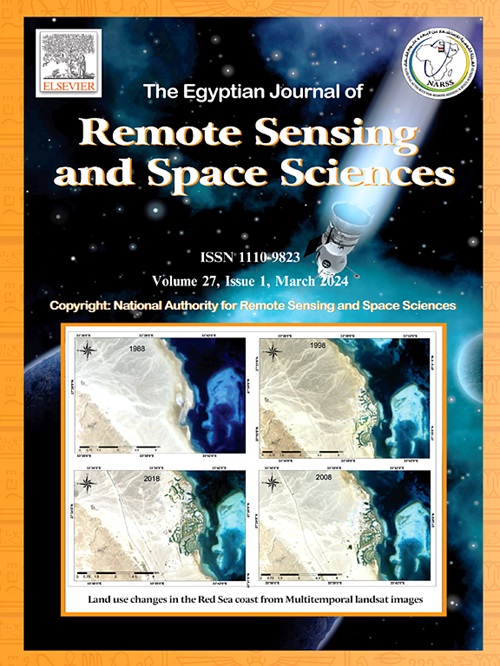Surface deformation of the 26 January 2021 earthquake in the Sinjar – Hasakah Area, N Iraq and NE Syria, from Sentinel‑1A InSAR images
IF 3.7
3区 地球科学
Q2 ENVIRONMENTAL SCIENCES
Egyptian Journal of Remote Sensing and Space Sciences
Pub Date : 2025-02-07
DOI:10.1016/j.ejrs.2025.02.001
引用次数: 0
Abstract
The deformation of Earth’s surface caused by earthquakes stands as a critical geological hazard in regions characterized by active tectonic structures. This study investigates the impact of a low-to-moderate magnitude earthquake (Mw 4.9) that occurred on January 26, 2021, in the Sinjar – Hasakah area (N Iraq and NE Syria). This seismic event marks the most significant occurrence in the study area over the past 48 years. The earthquake’s moment tensor solution suggests the presence of a right-lateral (dextral) strike-slip fault. 4 Sentinel-1A SAR images were processed by the DInSAR technique to analyze the surface deformation and identify the seismogenic fault of the 26 January 2021 earthquake. The most significant deformation observed along these active faults ranged from – 7.56 cm (subsidence) to + 3.75 cm (uplift) in the ascending orbit, and from – 4.56 cm (subsidence) to + 4.61 cm (uplift) in the descending orbit along the Line of Sight (LOS). It is inferred that the Hasakah seismogenic fault is responsible for the 26 January 2021 earthquake. This fault is a NW-trending, steeply dipping seismically active dextral strike-slip basement fault that formed during the Late Pliocene structural inversion. It extends over 120 km from the vicinity of Hasakah city in the northwest into the epicentral area in the southeast, traversing the boundary between the Sinjar and Abd El Aziz uplifts. Moreover, this seismogenic fault intersects with an active E-trending, S-dipping thrust basement fault that cuts through the northern limbs of both the Abd El Aziz and Sinjar anticlines.
求助全文
约1分钟内获得全文
求助全文
来源期刊
CiteScore
8.10
自引率
0.00%
发文量
85
审稿时长
48 weeks
期刊介绍:
The Egyptian Journal of Remote Sensing and Space Sciences (EJRS) encompasses a comprehensive range of topics within Remote Sensing, Geographic Information Systems (GIS), planetary geology, and space technology development, including theories, applications, and modeling. EJRS aims to disseminate high-quality, peer-reviewed research focusing on the advancement of remote sensing and GIS technologies and their practical applications for effective planning, sustainable development, and environmental resource conservation. The journal particularly welcomes innovative papers with broad scientific appeal.

 求助内容:
求助内容: 应助结果提醒方式:
应助结果提醒方式:


